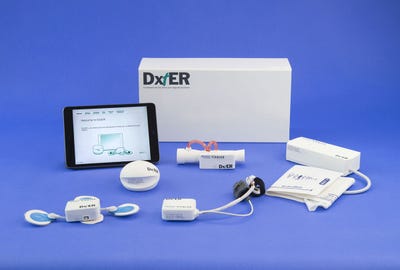April 25, 2017
A Pennsylvania-based team invented a diagnostic tool inspired by Star Trek and landed millions of dollars to bring it to market.
Nancy Crotti

Final Frontier Medical Devices won the Qualcomm Tricorder XPRIZE for its DxtER prototype device.
A family of engineers and doctors has taken their commitment to science and technology, and devotion to a futuristic TV show, to boldly go where no one has gone before--they invented an actual Tricorder.
Final Frontier Medical Devices, made up of siblings Basil Harris, MD, George Harris, Gus Harris, MD, and Julia Harris, plus a few friends, won the $2.6 million XPRIZE competition and financial assistance to bring its device to market. A second-place prize of $1 million was granted to Taiwan-based finalist, Dynamical Biomarkers Group, led by a Harvard Medical School associate professor, Chung-Kang Peng, PhD, and supported by HTC Research.
Learn how to prepare for the next industrial revolution through machine learning, IoT, and artificial intelligence, at the MD&M East conference and expo, June 13-15, 2017, in New York. |
The Qualcomm Foundation, which sponsored the global competition, challenged teams to develop a consumer-focused, mobile integrated diagnostic device inspired by the medical Tricorder of Star Trek fame, first shown to TV viewers more than 50 years ago. Final Frontier developed an affordable device designed to diagnose and interpret a defined set of 13 health conditions to various degrees, while continuously monitoring five vital health metrics.
Led by brothers Basil Harris, an emergency medicine physician, and George Harris, a network engineer, Final Frontier created DxtER (pronounced "Dexter"), an artificial intelligence-based engine designed to learn learns to diagnose medical conditions by integrating learnings from clinical emergency medicine with data analysis from actual patients. DxtER includes a group of non-invasive sensors designed to collect data about vital signs, body chemistry, and biological functions. The information is then synthesized in the device's diagnostic engine to make a quick and accurate assessment.
Unlike the other teams, Final Frontier worked on the diagnostics, and then the hardware, Basil Harris told Qmed. An engineer-turned-physician and a Star Trek fan, he relished the opportunity to make the Tricorder a reality.
As an ER doctor, Harris makes diagnoses all day for a diverse group of patients at Lankenau Hospital, just outside Philadelphia.
"People come in, I look at their vital signs and do some tests, and put it together," he said. "That's the nuts and bolts of my job. It's not all drama and trauma."
DxtER is more like a medical kit than an actual whirring, beeping Tricorder. It provides videos on a smartphone or tablet to guide people with little to no medical background on how to perform a medical exam, and suggests the types of tests a patient needs.
Harris foresees DxtER being used in parts of the world that have inadequate medical care, such as remote villages and refugee camps, and also among medically underserved populations in the United States.
First, it has to gain regulatory approval. Each of the device's 13 diagnostic components will have its own clinical trial, some of which are already underway at Lankenau Hospital and at the University of California at San Diego. The one that makes Harris the most proud is a sensor designed to measure blood glucose, hemoglobin, and white cell count without drawing blood.
He is optimistic about the future of his device and others like it, just like the way the original Star Trek TV series was optimistic.
"This stuff is coming, whether it's from my group or others," he said. "I just hope we can push the manufacturers to do the proper tests and things to get it done right."
Nancy Crotti is a contributor to Qmed.
About the Author(s)
You May Also Like


